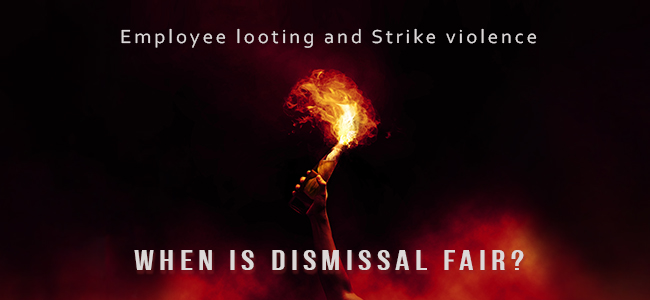
Employee Looting and Strike Violence: When Is Dismissal Fair?
Employee looting and/or violence can take place during strike action or it can occur during non-workplace incidents such as the recent looting and public disorder sprees. In both cases employers need to take action, but with care.
Addressing firstly the “strike” scenario, employees have strongly entrenched rights when it comes to taking industrial action. But strikers who indulge in, or associate themselves with, any form of violence or intimidation can expect little sympathy from our courts.
Two Labour Appeal Court decisions illustrate -
Dismissed for associating with a crowd assault
“Within a labour law context the requisite intention exists where it is proved that an employee intended that misconduct would result or must have foreseen the possibility that it would occur and yet, despite this, actively associated himself or herself reckless as to whether such misconduct would ensue” (extract from the judgment below)
First up is the case of 148 workers dismissed for misconduct during a strike.
- When the employer’s Human Resources Manager left his office to engage with the strikers they surrounded and seriously assaulted him. He was pushed out of a glass window, had rocks thrown at him and was punched and kicked while he lay on the ground. He feared for his life and was left with injuries to his face, arm, and body. Video footage showed striking employees celebrating and chanting after the assault was over.
- At a disciplinary hearing 12 employees were found to have participated directly in the assault, and the others were found to have participated by association and thus to have acted with “common purpose”. All were summarily dismissed.
- The Labour Court confirmed all 148 dismissals. 41 of the employees appealed to the Labour Appeal Court on the grounds that common purpose in the assault had not been proved because there was no evidence that they had been on the scene of the assault, nor that they had been aware of the assault, had intended to make common cause with it, or that they had performed an act of association with it.
- Quoting from the Constitutional Court that “it was unnecessary to place each employee on the scene to prove common purpose which can be established by inferential reasoning having regard to the conduct of the workers before, during and after the incident of violence” and commenting that “…the inference drawn that all employees were involved in or associated themselves with the assault became the most probable and plausible”, the Court held that the 41 had been present at the scene and had associated themselves with the actions of the group before, during or after the misconduct. The Court accordingly confirmed the dismissals.
Dismissed for carrying sticks, piping, and a sjambok in a picket line
“The constitutionally protected right to strike does not encompass a right to carry dangerous weapons on a picket line which, by their nature, not only expose others to the very real risk of injury, but also serve to threaten and intimidate” (extract from the judgment below)
The second case saw a group of employees dismissed after taking part in a national strike which turned violent.
- Three of the employees each carried a stick while picketing with a group of other strikers, another carried a length of PVC pipe and the fifth carried both a stick and a sjambok. Others in the crowd carried a golf club and an axe respectively. At least two people sustained severe injuries during the course of the strike.
- The employees were charged with “brandishing or wielding of dangerous weapons during [the] strike” and following disciplinary hearings they were dismissed.
- When the matter eventually came before the Labour Appeal Court, it upheld the dismissals, finding that the strikers were aware of a workplace picketing rule barring weapons of any kind being “carried or wielded” by picketers and that they “knew or could reasonably have been expected to have known that disciplinary action could result if the picketing rules were breached.”
- The end result is yet another warning to employees that whilst their right to strike is strongly protected by constitutional principles, strikes and picketing become unlawful if they are not peaceful, non-violent, and free of dangerous weapons.
What about off-duty employees who took part in the recent public looting?
Published images and videos of the recent orgy of public looting and destruction show criminal behaviour so blatant and shameless that many of the perpetrators will no doubt be readily identifiable by their employers.
You may feel justified in proceeding immediately against any of your employees so implicated, even though they happened to be off-duty and nowhere near your workplace at the time. After all, who wants a looter or arsonist working for them?
But whilst our laws may well entitle you to take action against some or all of such employees, that will generally be so only when their provable criminality is in some way linked to, and relevant to, their employment. The law in this regard is unfortunately too complex, and too full of grey areas, for any advice beyond the general observation that you should certainly consider immediate disciplinary action, with the strong caution that specific professional advice is essential beforehand.
Provided by Scheibert & Associates Inc
© DotNews. All Rights Reserved.
